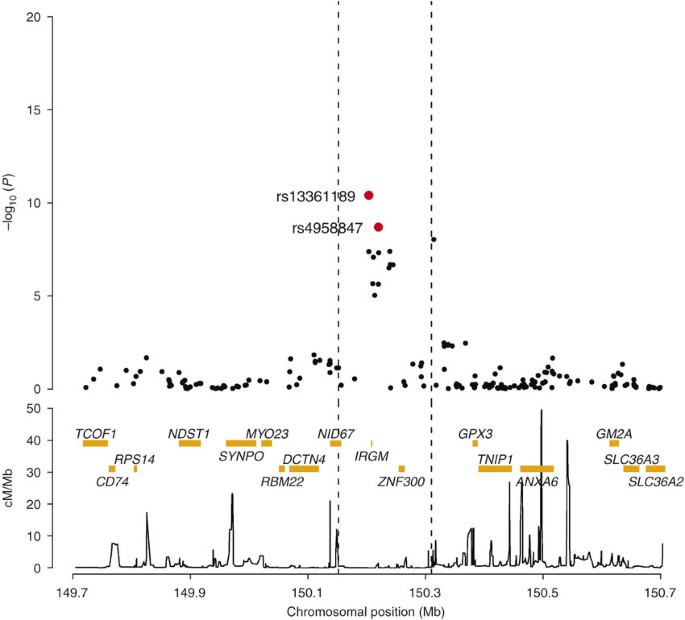Sequence variants in the autophagy gene IRGM and multiple other replicating loci contribute to Crohn's disease susceptibility
- Select a language for the TTS:
- UK English Female
- UK English Male
- US English Female
- US English Male
- Australian Female
- Australian Male
- Language selected: (auto detect) - EN

Play all audios:

A genome-wide association scan in individuals with Crohn's disease by the Wellcome Trust Case Control Consortium detected strong association at four novel loci. We tested 37 SNPs from these
and other loci for association in an independent case-control sample. We obtained replication for the autophagy-inducing IRGM gene on chromosome 5q33.1 (replication P = 6.6 × 10−4, combined
P = 2.1 × 10−10) and for nine other loci, including NKX2-3, PTPN2 and gene deserts on chromosomes 1q and 5p13.
We acknowledge use of DNA from the 1958 British Birth Cohort collection (R. Jones, S. Ring, W. McArdle and M. Pembrey), funded by the UK MRC (grant G0000934) and The Wellcome Trust (grant
068545/Z/02). We also acknowledge the National Association for Colitis and Crohn's disease and the Wellcome Trust for supporting the case DNA collections and UCB Pharma for supporting this
study with an unrestricted educational grant. We thank D. Kelberman, all subjects who contributed samples and consultants and nursing staff across the UK who helped with recruitment of study
subjects.
Miles Parkes, Jeffrey C Barrett and Natalie J Prescott: These authors contributed equally to this work.
Inflammatory Bowel Disease Research Group, Addenbrooke's Hospital, University of Cambridge, Cambridge, CB2 2QQ, UK
Bioinformatics and Statistical Genetics, Wellcome Trust Centre for Human Genetics, University of Oxford, Roosevelt Drive, Oxford, OX3 7BN, UK
Department of Medical and Molecular Genetics, King's College London School of Medicine, Guy's Hospital, London, SE1 9RT, UK
Natalie J Prescott, Sheila A Fisher, Roland G Roberts, Dianne Soars, Saud A Khawaja, Richard Bagnall, Clive M Onnie, Cathryn M Lewis & Christopher G Mathew
Division of Medical Sciences, Gastrointestinal Unit, School of Molecular and Clinical Medicine, University of Edinburgh, Western General Hospital, Edinburgh, EH4 2XU, UK
Elaine R Nimmo, Hazel Drummond, Charlie W Lees & Jack Satsangi
Gastroenterology Unit, Radcliffe Infirmary, University of Oxford, Oxford, OX2 6HE, UK
Department of Gastroenterology and Hepatology, University of Newcastle upon Tyne, Royal Victoria Infirmary, Newcastle upon Tyne, NE1 4LP, UK
Avon Longitudinal Study of Parents and Children (ALSPAC), University of Bristol, 24 Tyndall Avenue, Bristol, BS8 1TQ, UK
Division of Community Health Services, St George's University of London, Cranmer Terrace, London, SW17 ORE, UK
The Wellcome Trust Sanger Institute, Wellcome Trust Genome Campus, Hinxton, Cambridge, CB10 1SA, UK
Institute for Digestive Diseases, University College London Hospitals Trust, London, NW1 2BU, UK
Department of Gastroenterology, Guy's and St Thomas' NHS Foundation Trust, London, SE1 7EH, UK
M.P., J.S., J.C.M., D.P.J. and C.G.M. are principal investigators for the five participating centers; E.R.N., C.B. and P.D. did DNA extraction, normalization and quality control; W.M. and
D.S. supplied control DNA samples; M.T., F.R.C., H.D., C.W.L., S.A.K., C.E.T., T.A., C.M.O., A.F. and J.S. recruited study subjects and extracted phenotype data; N.J.P., R.G.R., R.B., D.A.B.
undertook genotyping and sequence analysis and G.B. performed expression analysis; J.C.B., C.A.A., S.A.F., C.M.L. and L.C. undertook the statistical analysis; WTCCC provided initial data
for Crohn's disease and other case-control panels and M.P., J.C.B. and C.G.M. wrote the manuscript. Members of the WTCCC are listed in the Supplementary Note online.
Anyone you share the following link with will be able to read this content: